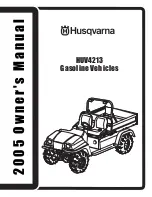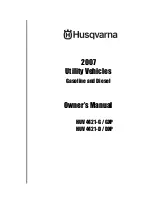
20
Tire Size
To maintain tire safety, purchase new tires that are the same size as the
vehicle’s original tires or another size recommended by the manufacturer.
Look at the tire information placards, the owner’s manual, or the sidewall
of the tire you are replacing to find this information. If you have any doubt
about the correct size to choose, consult with the tire dealer.
Tire Tread
The tire tread provides the gripping action and traction that prevent your
vehicle from slipping or sliding, especially when the road is wet or icy. In
general, tires are not safe and should be replaced when the tread is worn
down to 1/16 of an inch. Tires have built-in tread wear indicators that let
you know when it is time to replace your tires. These indicators are raised
sections spaced intermittently in the bottom of the tread grooves. When
they appear “even” with the outside of the tread, it is time to replace your
tires. Another method for checking tread depth is to place a penny in the
tread with Lincoln’s head upside down and facing you. If you can see the
top of Lincoln’s head, you are ready for new tires.
Tire Balance and Wheel Alignment
To avoid vibration or shaking of the vehicle when a tire rotates, the tire
must be properly balanced. This balance is achieved by positioning
weights on the wheel to counterbalance heavy spots on the wheel-and-
tire assembly. A wheel alignment adjusts the angles of the wheels so
that they are positioned correctly relative to the vehicle’s frame. This
adjustment maximizes the life of your tires. These adjustments require
special equipment and should be performed by a qualified technician.
Tire Repair
The proper repair of a punctured tire requires a plug for the hole and
a patch for the area inside the tire that surrounds the puncture hole.
Punctures through the tread can be repaired if they are not too large, but
punctures to the sidewall should not be repaired. Tires must be removed
from the rim to be properly inspected before being plugged and patched.
Tire Fundamentals
Federal law requires tire manufacturers to place standardized information
on the sidewall of all tires. This information identifies and describes the
fundamental characteristics of the tire and also provides a tire identification
number for safety standard certification and in case of a recall.
U.S. DOT Tire Identification Number
– This begins with the
letters “DOT” and indicates that the tire meets all federal standards.
The next two numbers or letters are the plant code where it was
manufactured, and the last four numbers represent the week and
year the tire was built. For example, the numbers 3197 means the
















































